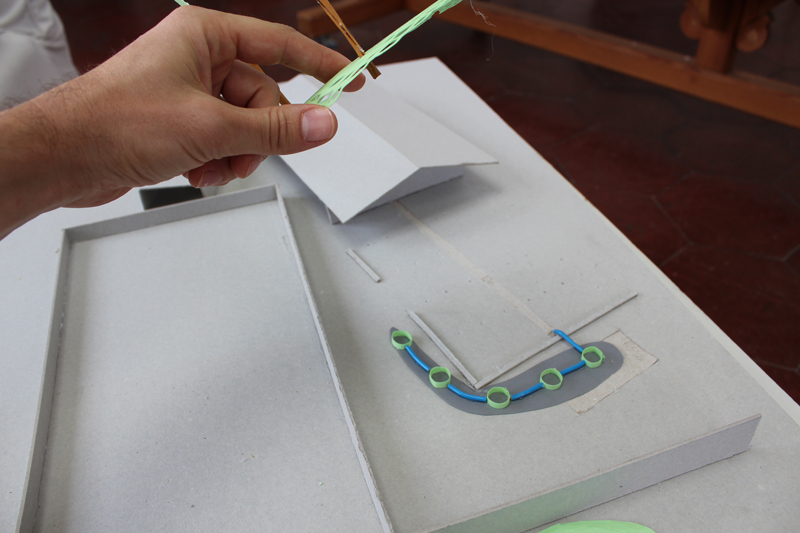Landscape Architecture for Landscape Architects › Forums › DETAILS & MATERIALS › Planting large trees above grade-technical/material considerations.
- This topic has 1 reply, 4 voices, and was last updated 10 years, 7 months ago by
 Rob Halpern.
Rob Halpern.
-
AuthorPosts
-
April 28, 2015 at 6:27 am #151955
 Daniel PhillipsParticipant
Daniel PhillipsParticipantHi All,
I am currently working on a tree-based intervention on a particularly difficult site and have something of a technical challenge that I’m hoping to get some insight about. We are working on a post-industrial site (former factory) our goal is to provide a low maintenance way to grow a few big, healthy trees on the site without actually digging down below the concrete/asphalt that is already there. We do not have access to any drawings that would show the placement of gas/water/sewer lines, so we’ve decided not to risk actually digging. We also don’t have access to running water, so it’s quite a difficult challenge.The idea, then, is to create an elevated ground condition using sandbags as a cheap/flexible retaining wall, that provides space for enough soil volume/height to grow the trees (approx. 1000 cubic feet per tree). To overcome the water issue, a modified SIP system capable of capturing rainwater from an adjacent roof structure and holding/transferring it though a series of connected storage troughs that sit at the bottom of our “birm” will be used.At the risk of turning this into a dissertation, I’ve just a couple of specific questions to run by the forum:Any suggestions about how to create the kind of thickness and integrity we’d need with the sandbags? There’s some detail sketches included here. We’re essentially creating a 4′ channel and filling in with soil (1′ at the bottom for the sip system).Does anyone have any experience “Perforating” asphalt assist in the tree root anchoring and drainage?Any other suggestions or advice in this case?Any constructive thoughts would be greatly appreciated.Best,DanielApril 28, 2015 at 5:52 pm #151962 Rob HalpernParticipant
Rob HalpernParticipantThoughtful selection of tree species and correct size will be key in making this work. Large nursery trees require far more care for more years than smaller specimens. In any case you can’t plant them and walk away if you want them to survive.
Your pyramid plan leaves very little space for roots to spread out. The trees will quickly become root bound (although I fully expect they will root in between the sand bags). As the tree grows it stands an excellent chance of blowing over.
The second diagram could be re-thought so as to create more root space with fewer sandbags.
April 28, 2015 at 6:58 pm #151961 Mark Di LucidoParticipant
Mark Di LucidoParticipantEven when we have access to drawings that purportedly show where underground utilities are it’s still prudent to Blue-stake (utility locate) an area before any construction. Normally this is a free service so why not go this route? With verified locations you’d know where you can and can’t sawcut, excavate/install trees.
Planting them as per your detail may work–for awhile, but I doubt if they’d get large or be healthy for long. Your ‘or’ sketch version is better because trees have most of their roots in the first foot of soil and so this version would facilitate stronger anchorage as well as access to more oxygen and nutrients.
Your soil volume of 1000 cubic feet per tree is a good start but if the height (as indicated in your sketch) is 4′ then the footprint is sizable (16’x16’ if square). Designing a smaller footprint makes your sand bag container height taller, further separating human interaction (use as a seatwall for example) with the trees which I suspect is important in your design. Also, the higher your container the further the roots are from your water trough.
Tough site—I don’t envy you this project.
April 29, 2015 at 9:21 am #151960 Daniel PhillipsParticipant
Daniel PhillipsParticipantThanks so much Mark, this project is in Rome, IT with a slightly different regime for the marking of utilities (everything is mired in bureaucracy). Your point about depth/footprint is well taken. Looking forward to making progress.
Glad to find this forum!
Best,
Daniel
April 29, 2015 at 11:08 pm #151959 Robert AndersonParticipant
Robert AndersonParticipantInteresting approach to an all too common issue. I do a lot of consulting work here in Washington DC and most, if not all the work is on structure, which is very similar to your condition. Your idea of using sand bags I suppose is an effort to be cost effective however you are going to have to line the system with something to keep the water in or you’ll have to use mortar sacks and soak them and let them set up. Is it possible that you can find material on site that you can reuse i.e. the slab it is sitting on. If you can cut it up you could have some wonderful Italian stone masons, unless they have all emigrated to the US, build up a free standing dry stacked wall and then do a parged on mortar backing with the cross section more like you or option not steeply battered in your first sketch.
As or your volume of soil. I’ve worked extensively with Jim Urban and his rule of thumb is 1,200 cu. ft. of soil per caliper inch of tree, ideally. We generally stick with 800 to 1,000 if we can get that. You really need to increase your soil volume given that you are in a Mediterranean climate. Hope this helps and not hurts.
May 3, 2015 at 5:10 pm #151958 Daniel PhillipsParticipant
Daniel PhillipsParticipantThanks Robert,
I appreciate your insight as well. We are in the process of getting some material quotes at the moment that will certainly impact the scale/approach. We are thinking of going with Ginkgo trees (hopefully three) with an initial trunk diameter of about 6″ and a canopy of 8′. The total volume of soil is approx 3-4,000 cu. ft.
Your idea of the mortar sacks is also interesting. Beyond the increased structural stability, do you suppose those are any cheaper than the sand bags?
May 3, 2015 at 5:13 pm #151957 Daniel PhillipsParticipant
Daniel PhillipsParticipantAlso-does anyone have any specific feedback on the sub-irrigation system? I’m hoping to get them at least 6″ deep with an overflow near the top of that. I’m wondering if it’s necessary/ideal to have them directly under the root ball or if it’s ok/better to slightly offset. Any insight would be very helpful.
Best,
Daniel
May 3, 2015 at 6:58 pm #151956 Robert AndersonParticipant
Robert AndersonParticipantNot sure about the cost associated with the mortar versus the sand. The carbon footprint of mortar is higher but as you may or may not know there is a shortage of sand for concrete and mortar world wide and most acutely felt in India.
There is a growing body of evidence that the larger you go in caliper size the longer it takes for a tree to get established and for each caliper inch you are adding a year before you will see any real new growth. Might I suggest that you dial back on the size and whatever money you save apply that toward increase the size of you planting area or you wall system. You really don’t need more than 3′ of soil depth.
As for the sub-irrigation system you should employ best practices in your locality. My memory serves me correctly there is an extensive amount of drip irrigation used. There are tree root zone irrigation available from Rainbird that we have use and it seems to work well. One critical portion to using this is that you need soil with great capillary capacity.
-
AuthorPosts
- You must be logged in to reply to this topic.





